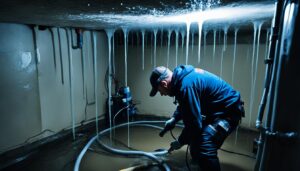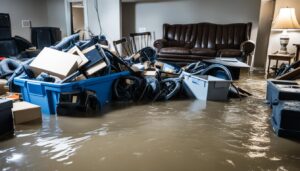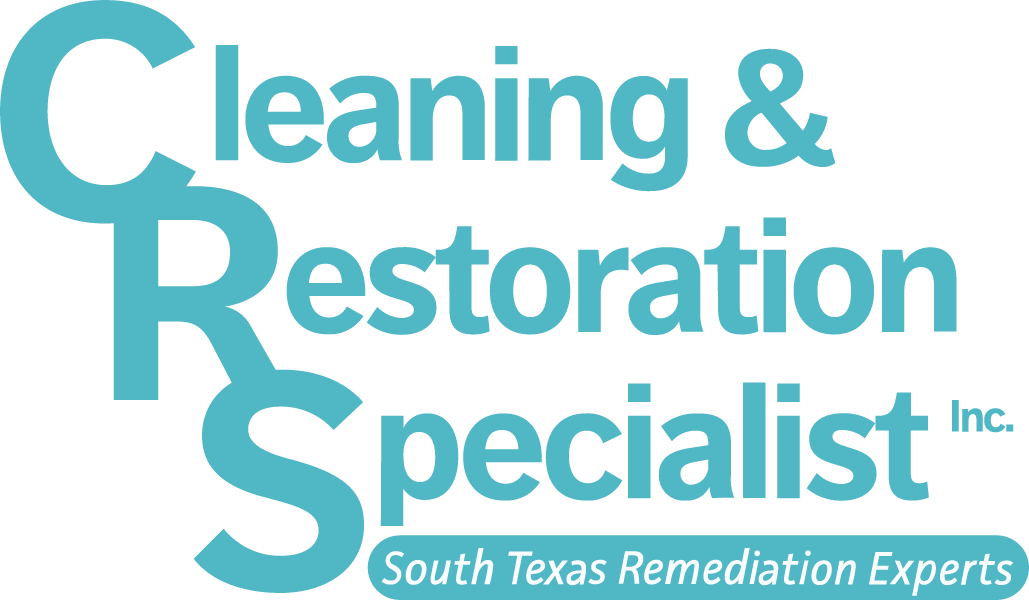Did you know that sewage backups affect thousands of homes every year in the United States? This alarming statistic highlights the scale of the problem and the impact it can have on homeowners. Sewage backup is not only a nuisance but can also lead to extensive damage and health risks. Understanding the causes of sewage backup is essential for prevention and timely intervention.
Key Takeaways:
- Blocked or clogged pipes, tree roots infiltrating sewer lines, cracked sewer pipes, heavy rainfall, and municipal sewer issues are common causes of sewage backup.
- Signs of sewage backup include bad odor, slow-moving drains, gurgling noises, water backing up from drains, wet floor drains, and changes in the yard.
- Regular inspection of sewer lines, proper disposal of grease and non-flushable items, and timely replacement of old sewer lines can help prevent sewage backups.
- If a sewage backup occurs, immediate steps such as avoiding direct contact with raw sewage and contacting a professional plumber should be taken.
Understanding Sewer Systems and Main Sewer Lines
A sewer system is an essential component of urban infrastructure for the proper disposal of wastewater from homes and buildings. It comprises various elements, including manholes, underground pipes, and pumping stations.
When wastewater is generated in a home or building, it flows into the sewer system through drains, toilets, and sinks. The wastewater is then transported through the underground pipes to sewage treatment plants, where it undergoes treatment before being released back into the environment.
The main sewer line serves as the primary conduit for carrying all the wastewater from a home to the septic tank or the public city connection. Typically located outside or in the lowest part of a home, it is connected to the internal pipes that serve toilets, sinks, and drains.
A sewage backup in the main sewer line can have serious consequences, such as contamination of the water supply and potential health risks for residents.
Understanding the components and processes involved in a sewer system is crucial for comprehending the complexities of wastewater drainage and the importance of maintaining its proper functioning. By familiarizing ourselves with the underground network of pipes, manholes, pumping stations, and sewage treatment plants, we can better appreciate the significance of preventing sewage backups and safeguarding the integrity of our sewer systems.
Initial Indicators of a Sewage Backup
Recognizing the early signs of a sewage backup is crucial for prompt intervention and preventing further damage. Some initial indicators of a sewage backup include the presence of a foul smell or signs of sewage in the home, slow-moving drains in multiple areas, gurgling noises coming from toilets and drains, water backing up from tubs or showers, wet floor drains in the basement or laundry area, and noticeable changes in the yard such as sinkholes, lush spots, or water pooling.
These signs suggest that the water flow in the main sewer line is blocked or impeded, causing the wastewater to back up into the home through various outlets. If any of these signs are noticed, it is important to call a professional plumber immediately to assess and resolve the issue.
Common Culprits Behind Blocked Sewage Lines
Blocked sewage lines are a frequent cause of sewage backups in homes. Understanding the common culprits behind blocked sewage lines can help homeowners take preventive measures and address the issue in a timely manner.
One of the primary culprits of blocked sewage lines is the accumulation of various substances within the pipes. Grease, hair, soap buildup, and solid materials can build up over time, resulting in clogged pipes that impede the flow of wastewater. This accumulation restricts the passage of sewage and can lead to backups in the system.
Tree roots are another significant cause of blocked sewer lines. Over time, tree roots can infiltrate sewer lines, causing blockages or creating holes that result in sewage backups. The roots can enter through small cracks or weak points in the pipes, and as they continue to grow, they can completely obstruct the flow of wastewater.
Damaged sewer pipes can also contribute to blocked sewage lines. Older pipes made of cast iron or clay are more prone to developing cracks, fractures, or collapses. These damages can occur due to various factors such as age, ground movement, or extreme weather conditions. When pipes are damaged, they can impede the flow of sewage and cause backups in the system.
In addition to internal factors, external factors can also contribute to blocked sewage lines. Heavy rainfall can overwhelm the municipal sewer system, causing excess water to back up into residential sewer lines. The increased volume of water puts pressure on the system and can lead to sewage backups in homes.
Issues in the municipal sewer system, such as blockages or malfunctions in the main sewer line, can also result in blocked sewage lines. When there are problems in the main sewer line, sewage backups can occur even if the individual homeowner’s pipes are clear. It is essential for homeowners to be aware of any ongoing issues with the municipal sewer system in their area.
By understanding the common culprits behind blocked sewage lines, homeowners can take proactive measures to prevent sewage backups. Regular maintenance, such as proper disposal of waste, clearing of tree roots, and timely replacement of damaged pipes, can help maintain the integrity of the sewer system and minimize the risk of blockages.
External Factors Contributing to Sewer Backups
Sewer backups can occur due to various external factors that are beyond the control of homeowners. Understanding these factors can help homeowners take preventive measures to minimize the risk of sewage backups.
One external factor that can contribute to sewer backups is heavy rainfall or flooding in a neighborhood. When the rainfall is excessive, it can overwhelm the capacity of the municipal sewer system, causing the water to back up into residential sewer lines. This can lead to sewage backups in homes and pose health risks to residents.
Aging sewer systems are also prone to sewage backups. Sewer lines made of clay or cast iron are more susceptible to deterioration and blockages over time. As these pipes age, cracks can develop, allowing debris and tree roots to infiltrate the sewer lines, leading to blockages and backups.
Earth movements, such as earthquakes, sinkholes, or land shifts, can also cause damage to sewer pipes and result in blockages or collapses. These natural events can disrupt the proper flow of wastewater, leading to sewage backups in homes.
Furthermore, municipal sewer issues can also contribute to sewage backups. Blockages in the main sewer line or malfunctions in the sewage treatment plants can cause the sewage to back up into residential properties. These issues are often beyond the control of individual homeowners and require the intervention of local authorities to rectify the problem.
To minimize the risk of sewer backups caused by these external factors, homeowners can take preventive measures. Regular sewer line inspections and maintenance can help identify and address any potential issues before they escalate. Additionally, ensuring proper landscaping practices, such as avoiding planting trees with invasive roots near sewer lines, can help prevent damage to the pipes.
Conclusion
Sewage backups can be a significant plumbing problem that poses health risks and causes damage to homes. Understanding the causes of sewage backups is crucial for prevention and timely intervention. Some common causes include blocked or clogged pipes, tree roots infiltrating sewer lines, cracked sewer pipes, heavy rainfall, and municipal sewer issues.
Recognizing the signs of a sewage backup can prompt action and help avoid further damage. Signs such as foul odor, slow-moving drains, gurgling noises, water backing up, wet floor drains, and changes in the yard indicate a possible sewage backup.
Regular sewer line inspections, proper disposal of grease and non-flushable items, and timely replacement of old sewer lines are key preventive measures to avoid sewage backups. In the unfortunate event of a sewage backup, it is essential to take immediate steps to protect the home and contact a professional plumber for assistance. By understanding the causes and taking preventive measures, homeowners can reduce the risk of sewage backups and ensure the proper functioning of their sewer systems.
FAQ
What causes sewage backup?
Sewage backup can occur due to various reasons, including blocked or clogged pipes, tree roots infiltrating sewer lines, cracked sewer pipes, heavy rainfall overwhelming the sewer system, and municipal sewer issues.
How does a sewer system work?
A sewer system consists of manholes, underground pipes, and pumping stations. It facilitates the proper disposal of wastewater from homes and buildings by transporting it through the underground pipes to sewage treatment plants, where it is treated before being released back into the environment.
What are the signs of a sewage backup?
The signs of a sewage backup include bad odor, slow-moving drains, gurgling noises, water backing up from drains, wet floor drains, and changes in the yard such as sinkholes or water pooling.
What are the common culprits behind blocked sewage lines?
Blocked sewage lines can be caused by clogged or blocked pipes due to the accumulation of grease, hair, soap buildup, or solid materials. Tree roots infiltrating sewer lines and damaged sewer pipes can also lead to blockages.
What external factors can contribute to sewer backups?
Heavy rainfall, flooding, aging sewer systems, and municipal sewer issues such as blockages or malfunctions can contribute to sewer backups in homes.
How can sewage backups be prevented?
Regular inspection of sewer lines, proper disposal of grease and non-flushable items, and timely replacement of old sewer lines can help prevent sewage backups. Taking preventive measures such as sewer line inspections and maintenance can help minimize the risk of sewer backups.
What should I do if a sewage backup occurs?
If a sewage backup occurs, it is important to avoid direct contact with raw sewage, remove affected items, turn off electrical power and water supply, and contact a professional plumber for assistance.









